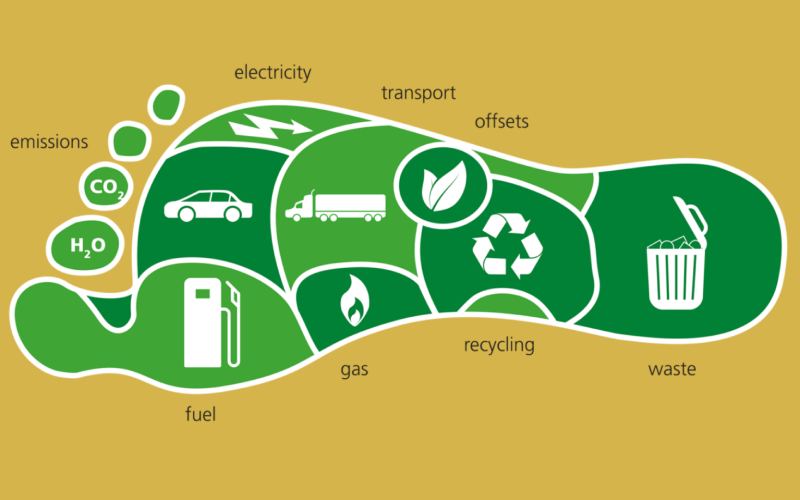Climate change can feel overwhelming, especially when it seems like every action we take has an environmental impact. While some people assume that reducing their carbon footprint requires drastic lifestyle changes—like giving up meat entirely, quitting driving, or moving to a tiny house, the truth is that small, intentional changes can make a significant difference. The key is to focus on practical strategies that fit your current life while gradually reducing your environmental impact.
Understanding Your Carbon Footprint
Your carbon footprint is the total amount of greenhouse gases, primarily carbon dioxide (CO₂), that are emitted directly or indirectly by your activities. This includes:
- Energy use in your home (heating, cooling, electricity)
- Transportation choices (car, plane, public transit)
- Diet and food production
- Consumption of goods and services
By identifying the areas with the largest impact, you can make smarter, targeted choices that reduce your footprint without completely overhauling your lifestyle.
Focus on Energy Efficiency at Home
Your home is one of the easiest places to reduce your carbon emissions:
- Upgrade Lighting: Switching from incandescent bulbs to energy-efficient LED bulbs can save both energy and money. LEDs use up to 80% less energy and last much longer.
- Smart Thermostats: Installing a smart thermostat allows you to optimize heating and cooling, reducing unnecessary energy consumption while keeping your home comfortable.
- Seal Leaks: Insulating your home and sealing gaps around windows and doors reduces energy waste, which lowers both your carbon footprint and utility bills.
- Energy-Efficient Appliances: Over time, replacing old appliances with energy-efficient models can dramatically reduce household emissions.
Even small changes, like turning off lights when not in use, unplugging devices, or lowering the thermostat by a few degrees in winter, can have cumulative effects.

Make Smarter Transportation Choices
Transportation is often a major contributor to individual carbon footprints. However, reducing emissions doesn’t necessarily mean giving up your car entirely:
- Combine Trips: Planning errands efficiently reduces total miles driven.
- Public Transit or Biking: Whenever feasible, use public transportation, bike, or walk short distances. Even a few trips per week make a difference.
- Car Maintenance: Keeping tires inflated and engines tuned improves fuel efficiency, reducing emissions.
- Carpooling or Ride-Sharing: Sharing rides with coworkers or friends lowers the number of vehicles on the road and your personal carbon output.
For longer trips, consider offsetting emissions by investing in verified carbon offset programs, though reducing travel is generally more impactful than offsets alone.
Adjust Your Diet Gradually
Food production, especially meat and dairy, contributes significantly to greenhouse gas emissions. You don’t need to become vegan overnight; small, manageable adjustments work well:
- Meatless Days: Introduce 1–2 meatless days per week to reduce emissions and diversify your diet.
- Local and Seasonal Foods: Buying local produce reduces emissions associated with long-distance transportation.
- Reduce Food Waste: Plan meals, store food properly, and compost scraps to minimize waste. Globally, food waste accounts for around 8–10% of greenhouse gas emissions.
Even subtle changes—like swapping one meal for plant-based options or choosing sustainably sourced seafood—can add up over time.
Mindful Consumption
The products we buy from clothing to electronics, have hidden environmental costs:
- Buy Less, Choose Quality: Instead of frequent purchases, invest in durable items that last longer.
- Secondhand and Upcycling: Thrift stores, vintage shopping, or repurposing items reduces demand for new production.
- Sustainable Brands: Support companies committed to environmentally friendly practices.
- Minimal Packaging: Choose products with less plastic and recyclable packaging whenever possible.
Small changes in shopping habits can significantly reduce the carbon footprint associated with production, shipping, and disposal of goods.

Water Conservation
Water usage is often overlooked, but it indirectly contributes to carbon emissions because treating and heating water consumes energy:
- Take shorter showers and turn off taps when not in use.
- Install low-flow fixtures in showers and faucets.
- Collect rainwater for gardening or outdoor cleaning.
- Run washing machines and dishwashers only when full.
These actions save both water and energy, making them an easy win for reducing your environmental impact.
Household Waste and Recycling
Proper waste management is another straightforward way to lower emissions:
- Recycle Properly: Follow local recycling guidelines to ensure plastics, glass, and paper are recycled correctly.
- Compost Organic Waste: Composting food scraps and yard waste reduces methane emissions from landfills.
- Avoid Single-Use Items: Use reusable bags, water bottles, and containers whenever possible.
Even small changes in waste habits, when practiced consistently, can reduce the overall burden on landfills and emissions associated with waste processing.
Advocate and Educate
While personal actions matter, systemic change is crucial for meaningful impact. You can contribute by:
- Supporting policies promoting renewable energy, public transit, and sustainable agriculture.
- Encouraging friends, family, and colleagues to adopt low-carbon practices.
- Participating in community programs like tree planting, local cleanups, or energy-saving initiatives.
By advocating and educating others, your efforts are multiplied, creating a ripple effect beyond your individual lifestyle.
The Key: Incremental Change
The most important takeaway is that you don’t need to overhaul your entire life to make a difference. Small, intentional steps—like swapping a few meals per week, biking instead of driving short distances, or upgrading home energy efficiency—add up over time. A consistent, incremental approach is more sustainable and realistic than attempting drastic, unsustainable changes.
Reducing your carbon footprint doesn’t have to feel overwhelming. By making thoughtful adjustments in energy use, transportation, diet, consumption, and waste, you can meaningfully contribute to a healthier planet while maintaining the life you enjoy. Every small action counts, and collectively, these efforts lead to significant reductions in greenhouse gas emissions.


